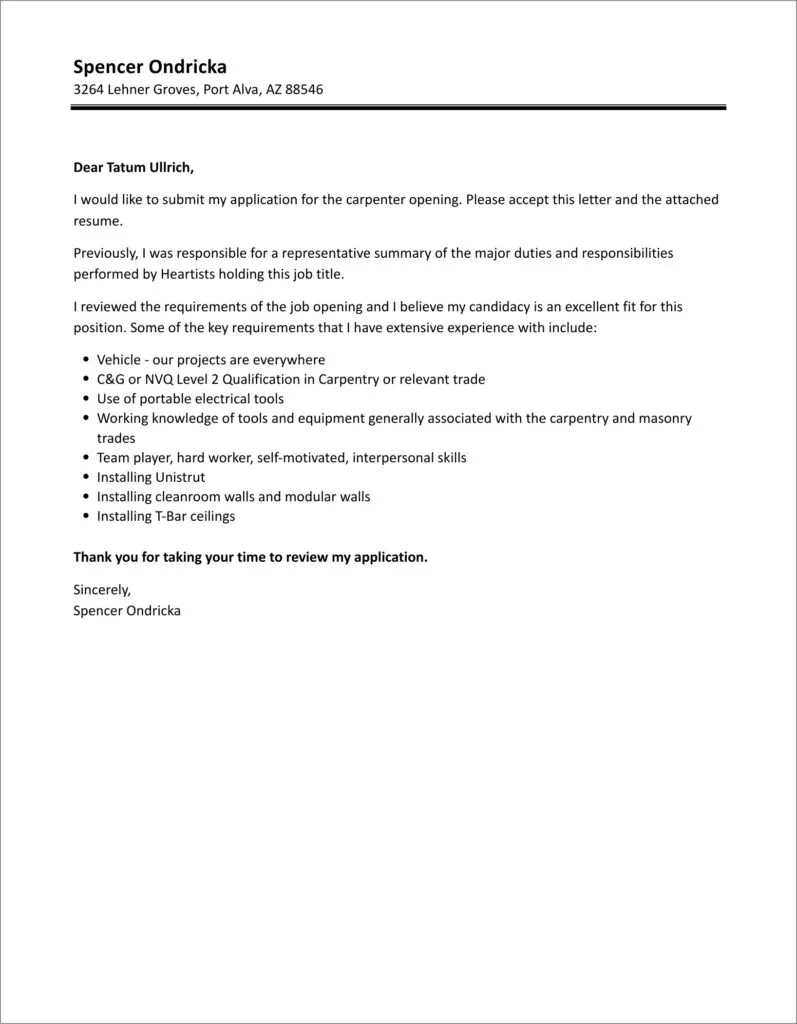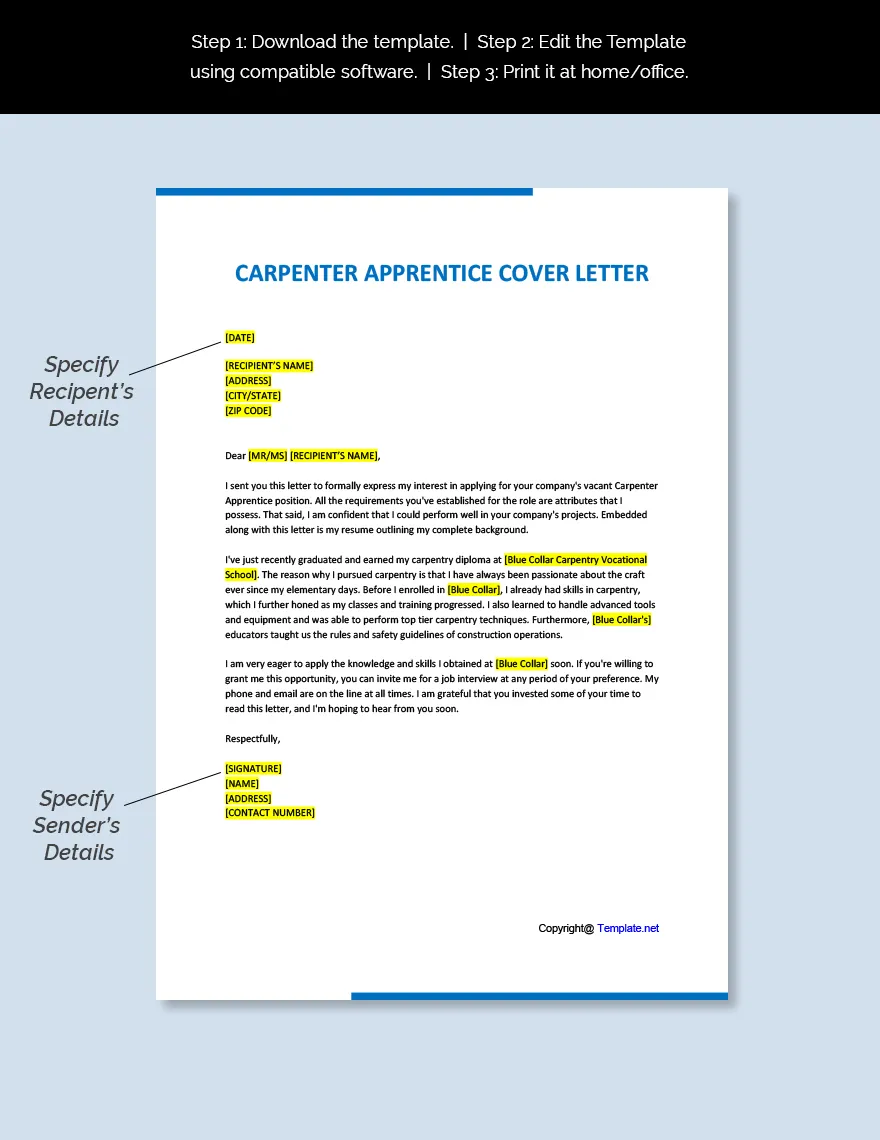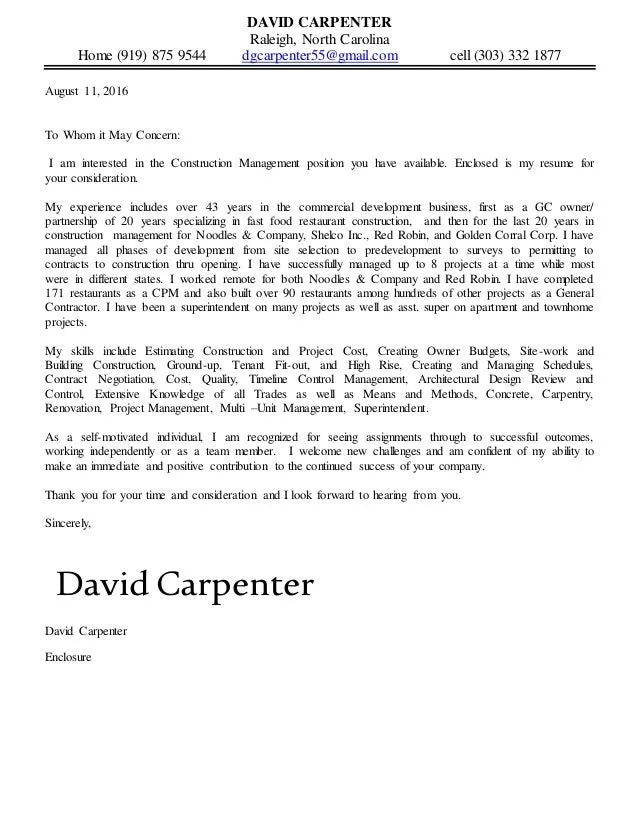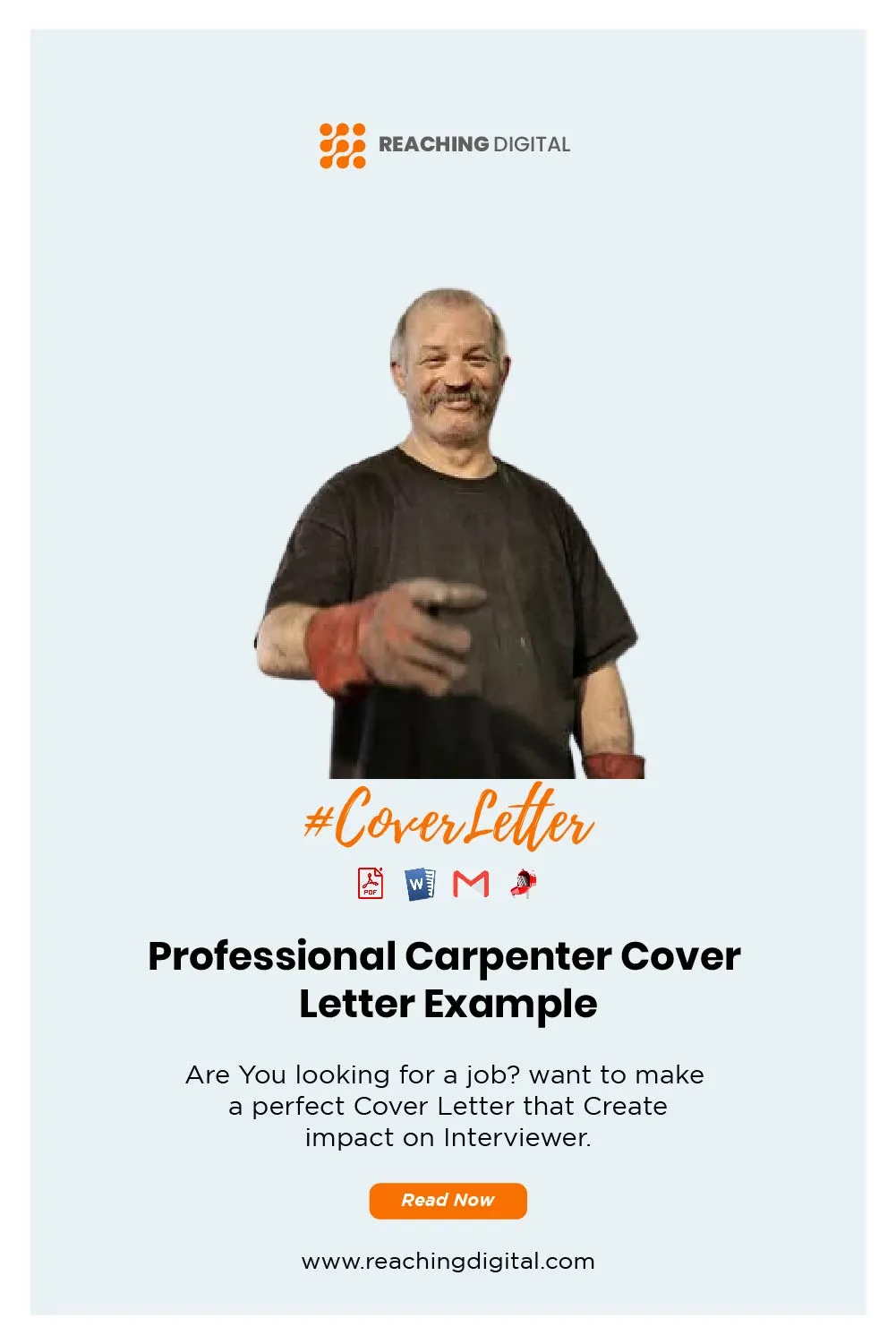The Power of a Carpenter Cover Letter
A well-crafted carpenter cover letter is your first opportunity to make a lasting impression on a potential employer. It serves as a crucial introduction, allowing you to showcase your skills, experience, and enthusiasm in a way that a resume alone cannot. The cover letter is your chance to go beyond the bullet points and tell a story, illustrating why you are the ideal candidate for the carpentry position. It’s where you can demonstrate your personality, your understanding of the role, and your genuine interest in the company. Neglecting this critical step can mean missing out on your dream job. A compelling carpenter cover letter should be viewed as a marketing tool, selling your abilities and demonstrating your value to the hiring manager. Properly used, it will significantly increase your chances of landing an interview and ultimately, the job. Remember that this document is not just a formality, but a strategic part of your application, so ensure to craft each detail carefully.
Highlighting Your Skills
Your carpenter cover letter should prominently feature your core carpentry skills. This includes proficiency in areas such as framing, finishing, cabinetmaking, and blueprint reading. Instead of simply listing your skills, provide brief examples of how you’ve utilized them in past projects. For instance, describe a project where you successfully framed a complex structure, showcasing your ability to work with precision and attention to detail. Similarly, if you excel at finishing work, mention projects where you’ve created stunning results that align with the project’s goals. Always align your highlighted skills with the job description. Identify the key requirements and then demonstrate how your abilities match those needs. Use action verbs like ‘constructed,’ ‘repaired,’ ‘installed,’ and ‘designed’ to make your descriptions more compelling. Use clear and concise language to avoid jargon. Always aim to give a clear picture of what you have done and what you can bring to the table to the employer.
Showcasing Relevant Experience

Beyond skills, emphasize your relevant experience. Highlight projects, roles, and responsibilities that are most pertinent to the job you’re applying for. If you’ve worked on residential, commercial, or specialized carpentry projects, be specific. For example, if the job requires experience in custom cabinetry, detail your experience in that area. Provide details about the scope of your projects, the materials you worked with, and any challenges you overcame. If you’ve supervised other carpenters, mention your leadership capabilities and the successful completion of projects under your guidance. The cover letter is the perfect place to link your past work with the requirements of the new role. If possible, include quantifiable results, such as the number of projects completed, the size of the teams you’ve led, or any improvements you brought about in efficiency or quality. Always show the employer the value you bring to the table.
Quantifying Achievements
To make your experience even more impactful, quantify your achievements whenever possible. Instead of saying you ‘completed many projects,’ state that you ‘successfully completed over 50 residential projects within the past year.’ Instead of claiming to ‘improve efficiency,’ mention that you ‘reduced project completion time by 15% through effective time management.’ These specific numbers add credibility and demonstrate your ability to deliver results. Include percentages, dollar amounts, or other measurable metrics. These metrics will provide clear evidence of your contributions and help the hiring manager understand the tangible value you can bring to their team. Be prepared to back up these claims with more detailed information during an interview. Focus on the results and demonstrate your skills effectively by using quantifiable language to showcase your professional accomplishments.
Emphasizing Skills for the Job
Tailor your cover letter to match the specific job description. Review the job posting carefully to identify the key skills and experience the employer is seeking. Then, make sure your letter clearly demonstrates that you possess those qualities. This may involve rearranging the order of your experience, highlighting specific projects, or adjusting your descriptions to align with the employer’s needs. For instance, if the job emphasizes the use of specific tools or materials, mention your familiarity with them. If teamwork and communication are important, provide examples of how you’ve successfully collaborated with others on past projects. Show the employer that you understand their needs and that you have the skills and experience they’re looking for. By highlighting the skills most relevant to the job, you significantly increase your chances of getting noticed and securing an interview.
Tailoring Your Cover Letter

One of the biggest mistakes is sending a generic cover letter. Tailoring your cover letter to each specific job is critical to making a positive impression. Generic letters come across as impersonal and show a lack of interest in the position. Start by researching the company and the specific role you’re applying for. Review their website, social media, and any other available information. This will help you understand their values, culture, and the type of projects they work on. Then, customize your letter to reflect what you’ve learned. Mention specific aspects of the company that appeal to you and explain how your skills and experience align with their needs. Show the hiring manager that you’ve taken the time to learn about their business. Customization shows the company that you have put in the work and that you want the job, increasing your chances of getting hired.
Researching the Company
Before you start writing, research the company thoroughly. Visit their website, read their ‘About Us’ page, and look for information about their projects, values, and company culture. If possible, find out who the hiring manager is and address your letter to them by name. This personalized approach shows that you’ve taken the time to learn about the company. By understanding the company’s needs and goals, you can then tailor your cover letter to emphasize how your skills and experience align with their specific requirements. Understanding the company’s mission and values can help you connect with the employer, and show why you would be a great fit for the company and its culture. By investing time in research, you’ll be able to create a more compelling and effective cover letter that stands out from the competition.
Using Keywords Strategically
Many companies use Applicant Tracking Systems (ATS) to screen resumes and cover letters. These systems scan for keywords related to the job description. Therefore, it’s essential to include relevant keywords in your cover letter. Carefully read the job posting and identify the key skills, qualifications, and requirements. Incorporate these keywords naturally throughout your letter. Be careful not to stuff your letter with keywords; instead, use them within the context of your sentences and descriptions. Use keywords in the summary of your skills, your work experience, and your overall qualifications. This not only helps your application get through the ATS but also demonstrates to the hiring manager that you possess the required skills and experience. Use keywords to help your cover letter highlight your ability to meet the requirements of the open position, increasing your chances of being selected for an interview.
Formatting and Presentation

The formatting and presentation of your carpenter cover letter are just as important as the content. Ensure your letter is easy to read and visually appealing. Use a professional font like Times New Roman, Arial, or Calibri. Keep the font size between 10 and 12 points. Use clear, concise language and avoid long blocks of text. Break up paragraphs and use bullet points to highlight key information. Proofread your letter carefully for any spelling or grammatical errors. A clean and well-formatted letter demonstrates your attention to detail, which is a crucial skill for a carpenter. A well-formatted cover letter makes it easy for the hiring manager to quickly scan your qualifications. The easier it is to read your cover letter, the more likely you are to capture the reader’s attention and make a positive impression.
Proper Salutation and Closing
Always begin your cover letter with a professional salutation. If possible, address the hiring manager by name; this shows you’ve done your research. If you’re unsure of the hiring manager’s name, use a general greeting like ‘Dear Hiring Manager.’ At the end of your letter, use a professional closing such as ‘Sincerely,’ ‘Best regards,’ or ‘Yours sincerely.’ Avoid overly casual closings. In the final paragraph, reiterate your interest in the position and include a call to action. State that you’re looking forward to the opportunity to discuss your qualifications further and provide your contact information. These details show your professionalism and your commitment to the job, leaving a lasting impression on the hiring manager and further increasing your chances of being hired.
Proofreading for Perfection
Thorough proofreading is crucial to ensure your cover letter is error-free. Spelling and grammatical errors can create a negative impression, suggesting a lack of attention to detail. Read through your cover letter multiple times, ideally after a break, to catch any mistakes you might have missed. Use a grammar checker and spell checker. However, don’t rely solely on these tools; they may miss subtle errors. Ask a friend or family member to proofread your letter. A fresh pair of eyes can often catch mistakes you might overlook. Proofreading is about attention to detail. Proofreading is not just a formality, but a critical step. A well-proofread cover letter demonstrates professionalism and respect for the hiring process, while a poorly proofread letter can lead to rejection, even if you have the required skills and experience.
Demonstrating Enthusiasm and Interest

Your cover letter is your chance to show your enthusiasm for the carpentry position. Instead of a generic letter, inject your personality and excitement into the content. Demonstrate your genuine interest in the specific opportunity and the company. Avoid writing a cover letter that comes across as a template. Instead, talk about your passion for carpentry, what attracts you to the role, and why you’re excited about the company. Enthusiasm can be shown by the way you talk about your past experiences. Be sure to use language that is strong and clear to leave a positive impression. Express your passion for your craft and connect it to the opportunity and how it can benefit the company.
Expressing Your Passion for Carpentry
In your carpenter cover letter, express your passion for carpentry. Share what you love about the trade. Describe your favorite aspects of the work, whether it’s the satisfaction of building something tangible, the precision required, or the creativity involved. Discuss any specializations that you love. Share what motivates you to keep improving and learning. Conveying your enthusiasm can make a significant impression. This enthusiasm communicates to the employer your commitment to your trade, helping them visualize you succeeding in the role. If you genuinely love your work, let it shine through. This not only makes your letter more engaging but also shows the employer that you are invested in your craft.
Connecting with the Company’s Values
Align your cover letter with the company’s values. If the company emphasizes quality craftsmanship, mention your commitment to detail and precision. If they focus on teamwork, provide examples of your collaborative experience. By demonstrating that your values align with theirs, you show that you are a good cultural fit. Mention any shared values you have with the company in the letter. Show your passion for their goals, their mission, and their culture. This makes a stronger case for why you’re a good match for the role and the company. This can be done through research and by showing your eagerness to be part of their team. This effort will greatly increase your chances of impressing the hiring manager and getting an interview.
Making a Strong Call to Action

Your carpenter cover letter should end with a strong call to action. Clearly state your interest in the position and your desire for an interview. Include your contact information and make it easy for the hiring manager to reach you. Express your eagerness to discuss your qualifications further and to learn more about the opportunity. A strong call to action makes it easy for the hiring manager to take the next step in the hiring process. It helps to show the employer that you want to be part of the team. Include your phone number and email address, and be prompt in responding to any communications to show the hiring manager you are prepared and ready to be part of the team. By providing clear and concise instructions, you increase the likelihood of securing an interview.
